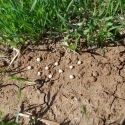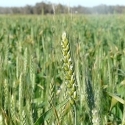29 Oct 2013
Nitrogen and sulfur for wheat and canola - protein and oil
Dookie Field Day October 31, 2013
 Nitrogen deficiency in canola
Nitrogen deficiency in canola
With plant nutrition, like many things in farming and life, there are some fundamental principles. Firstly, you get nothing for nothing – inputs need to be addressed relative to realistic outputs, if removals are greater than inputs, the soil nutrient stocks deplete. Secondly, address the big picture issues, which are those most likely to limit yields. In most cases this will be getting N, P and S supply balanced, and then making sure that the others are not limiting – you will only know if you test the soil. Finally, there are no silver bullets – if something sounds too good to be true – it probably is.
Nutrition in the high rainfall zone
When thinking about nutrition in the high rainfall zone (HRZ), there are a couple of important considerations that moderate our thinking. Generally the yield potential is driven by rainfall and accessible stored water and in many years the supply is good although variable. Subsoil limitations such as sodicity or acidity will restrict yield potential by restricting the amount of nutrient and water available to the roots – in this case, providing nutrients in small doses to prevent them getting beyond the roots is important. In both cases realistic yield estimates should drive the crop fertilizer program.
Secondly, make sure the soil pH is right – low pH is a major cause of micronutrient deficiency and strategic lime use should be considered if the soil pHCa is below 5.0 – get it tested and do a lime requirement test.
Thirdly, a paddock can show everything from deep soils to rocks, and so nutrient management needs to be adjusted accordingly. Deep fertile soils will have higher yield potentials so feed them appropriately – this does not need a detailed soil map (although one can help) but just your knowledge of the good and the bad. Lighter parts of the paddock may leach and so are lower in mobile nutrients (N & S), but the lighter soil can be more responsive to lighter rainfalls. Waterlogging is a challenge to nutrient management as nutrients can move away if surface water moves, but N can be lost through denitrification, so the N supply may need topping up when the paddock is trafficable. It also seems there are reports of low K on some lighter soils and/or where hay has been cut, although there is a need to confirm this –and here tissue testing or in-crop test strips can provide a guide.
Finally, because of the variable climate and uncertain rainfall, it is prudent to roll nutrients out as the season develops. At sowing, application (especially of N and S) should aim to meet the crop demand until stem elongation in either canola or wheat, and then reassess the yield potential and nutrient demand in the light of the seasonal forecast. If there is moderate N (say 40 to 50 kg N/ha top 60 cm), the crop will not suffer undue N stress, and yields will respond to added N. Early N will stimulate growth (shoot numbers/leaf growth) while later N will stimulate grain protein in both cereals (good) and canola (not so good), so balancing both is important.
N and S for wheat and canola
With those things in mind, selecting the right source (product) and applying it at the right rate, at the right time and putting it in the right place represent the keys to nutrient management, and these four Rights for wheat and canola are quite specific for the HRZ.
So with that introduction, why talk about N and S –what do they have in common? The common link is the proteins they from and the relative demands for each nutrient. Cereals typically have a grain N:S ratio of 15:1 while canola grain have a N:S of 7:1. So, the relative S demand of canola is twice the demand of cereals, and this is why we need to consider S particularly for canola. The total N (and P) demand for average wheat and canola crops is quite similar, but canola will need twice the S of cereals.
Table 1. Approximate nutrient removals (kg/ha) in canola and wheat crops.
Canola (3.5 t/ha) | Wheat (6 t/ha) | |
| Nitrogen | 122 | 126 |
| Phosphorus | 18 | 18 |
| Potassium | 25 | 22 |
| Sulfur | 18* | 8 |
Overview of N management for wheat and canola
Before worrying about S, the first challenge is to get N right. N demand can be estimated through a budget approach, and this requires a soil test (usually deep –to 60 cm) to estimate the amount of N at seeding. N supply will be supplemented by in-crop mineralization, which depends on soil organic matter and rainfall. The mineral N supply can then be balanced off against a potential N demand, which is usually considered as around twice crop removal (Table 1). Demand can be estimated using a French and Schulz estimate, or through Yield Prophet® or based on what is considered a reasonable for the season.
The big caution with N is its potential to damage seedling if the fertilizer placed too close to the seed at planting. Wide rows, narrow points, sandy soils and dry seedbed all conspire to damage seedlings unless the seeder is has twin chuting. Rates of 5 kg N/ha (50 kg MAP/ha or 25 kg DAP/ha or 10 kg urea/ha) are enough to cause this damage on wide rows with narrow points of dry sandy soils.
MAP will supply some N near the seed, and for both wheat and canola, review the demand/supply equation at the start of stem elongation, and if the season looks OK, then add enough N so that N is not limiting your target yield. Each 25 mm of rain will increase canola yield by 0.3 t/ha and wheat yield by 0.45 t/ha, and this means N demand will increase by around 25 kg N for canola and 21 kg N for wheat. Managing N is really then about estimating yield and then balancing the N supply as the season unfolds, either for better or worse.
Wheat and canola will respond quite well to top dressed N and S as late as booting (wheat) or first flowers (canola), but the efficiency of the N will be less than the an application made during the period of peak demand (stem elongation in both wheat and canola). While tissue testing can be of use, using paddock test strips or monitoring the crop for signs of nutrient stress can also give direction to the right time for action.
Management using the 4-R Nutrient Stewardship Principles
The 4-R Nutrient Stewardship Principles are that the Right Source of Nutrient is applied at the Right Rate, Right Time and Right Place to supply crop nutrient needs. These principles apply to all plant nutrients that are added as a supplement to nutrients used from the soil. N and S can be added in different sources and many sources can be effective if managed in the right way. Application of ammonium sulfate in the seed-row of canola could be very effective, but because required rates cause the N in the ammonium sulfate to exceed the ammonia tolerance of canola, germination mortality can be high and establishment of an adequate plant population stand is at risk.
The following are alternative ways of applying the 4-R principles to supply adequate amounts of N and S needed for the canola crop by changing the form and or placement of the S-containing product.
1. Spread out the needed application of S through the whole crop rotation, for example using good quality gypsum.
2. Deep soil test for N and S, the topsoil can be deficient while there may be adequate in the subsoil
3. Apply the N and S in a side band away from the seed-row.
4. Apply the N and S in a mid-row band along with the N, while the P and K are still applied in the seed-row.
5. Apply N and S later in the growth of the crop.
6. Apply a source of S that has both sulfate and fine-particle sized elemental S in the seed-row. Top-dressed S should be in the sulfate form.
7. There is some agronomic differences among different N sources, but in most cases, choose on price and convenience.
CONCLUSIONS
Growing canola in rotation with cereal crops requires more attention to S management. Applying all required S in the seed-row blend of canola is difficult because of excess N coming from the ammonium phosphate and ammonium sulfate that is part of the blend. There are alternative ways to supply sufficient S and avoid excess N in the seed-row.




